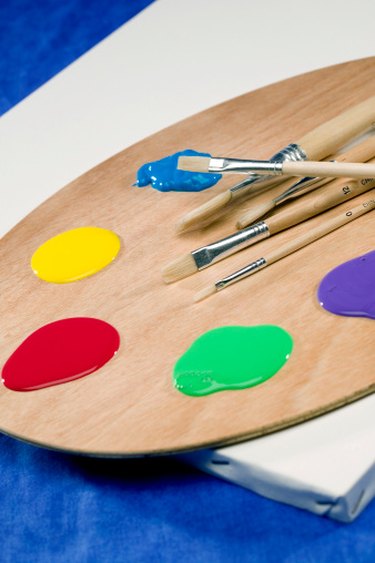Things You'll Need
Prepared canvas, panel or board
Pencil or charcoal
Palette
Round point bristle brushes
Painting medium
Permanent Violet paint
Ultramarine Blue paint
Viridian paint
Cadmium Yellow paint
Yellow Ochre paint
Cadmium Red paint
Alizarin Crimson paint

Pointillism is a painting technique where small dots of color are used to create an artistic image. Pointillism relies on the idea that two colors placed closely together or just overlapping will, from a distance, create the illusion of a single blended color. Georges Seraut popularized pointillism in the 19th century with his post-Impressionistic paintings full of light and vibrancy. While pointillism is a time consuming method of painting, the results can be rewarding for subjects best captured in luminous, pure colors. Any painting medium can be utilized in pointillism including oil, acrylic, watercolor and gouache.
Step 1
Sketch the subject of your painting on your prepared canvas, panel or board. Use pencil or charcoal sharpened to a fine point and a very light touch. Do not shade or indicate value, only outline and place crucial details.
Video of the Day
Step 2
Arrange paint on your palette in color wheel order: Permanent Violet, Ultramarine Blue, Viridian, Cadmium Yellow, Yellow Ochre, Cadmium Red and Alizarin Crimson. Place colors far enough apart that they will not mix on your palette.
Step 3
Load a round point bristle brush with medium and mix it into one of your paint colors. Begin applying this single color where appropriate, using uniform-sized dots of paint. Densely apply the dots if this color represents the primary hue of an object. Sparsely apply the dots if the color is only a minor component in that portion of the image.
Step 4
Continue with a clean brush as you move on to the next color. Use color wheel theory in selecting which color dots to place next to each other in order to create the illusion of a blended color. Cadmium Red and Ultramarine Blue dots will create the impression of purple when viewed from a distance. Place dots close to or barely touching each other but do not layer the paint or allow it to mix on the canvas.
Step 5
Create dynamic shadows by placing complementary color dots next to each other, such as Viridian and Cadmium Red or Cadmium Yellow and Permanent Violet. Utilize Ultramarine Blue, Permanent Violet and Alizarin Crimson for dark passages. Continue working until the entire surface of the painting is evenly covered with dots of paint except for areas of bright light or highlights, where the white of the clean painting surface should show through.
Tip
Try combinations of color dots on scrap canvas or paper before applying them to your final work. Testing will help you determine which hues will combine successfully to create the colors you want.
Step back from your painting frequently to check your progress and determine how well your dots of color are blending to create a successful visual illusion.
Video of the Day